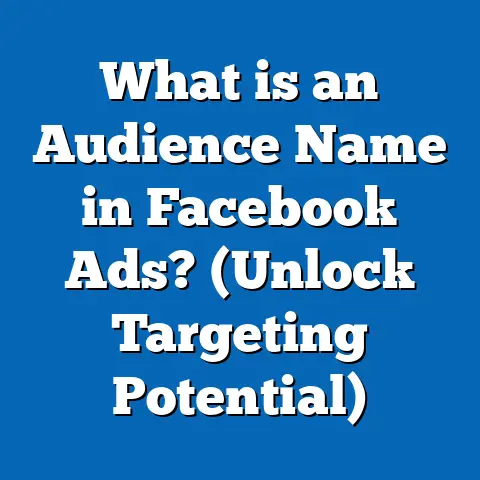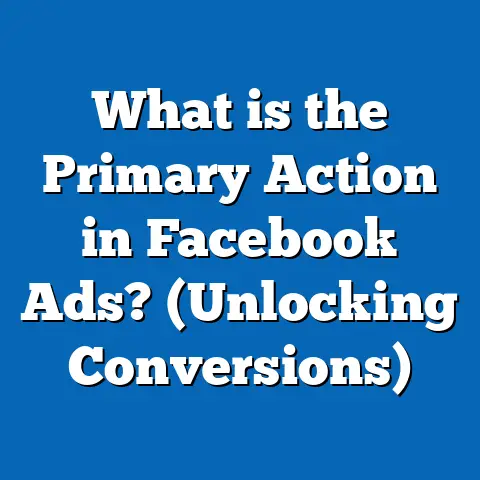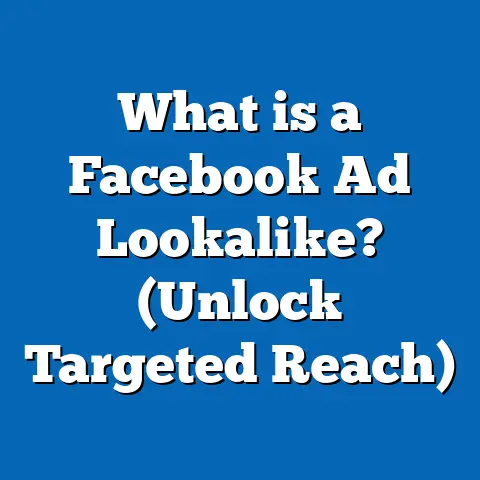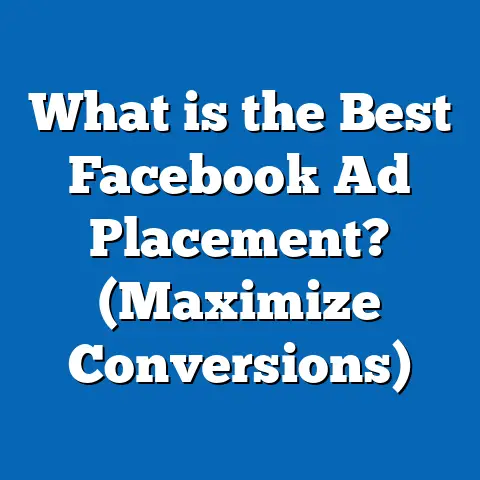What is ABO and CBO in Facebook Ads? (Unlocking Ad Strategies)
Introduction: The Secret Behind Facebook Ads Success — ABO and CBO
Imagine investing thousands of dollars into Facebook advertising campaigns only to realize that your budget isn’t being utilized effectively. Maybe you’re seeing inconsistent results or struggling to identify which audiences or creatives deserve the most spend. What if there was a way to automate this decision-making process or, alternatively, to take full control of your budget allocation down to every audience group?
This is the challenge—and opportunity—that Ad Set Budget Optimization (ABO) and Campaign Budget Optimization (CBO) address. These two budgeting models are fundamental to how Facebook’s advertising platform manages and distributes your ad spend, but many marketers still don’t fully grasp their differences or how to leverage them strategically.
In this extensive guide, you’ll learn everything you need to know about ABO and CBO: what they are, how they work, when to use each, and how to maximize their potential to improve your campaign results. By mastering these concepts, marketing professionals and business owners alike can unlock smarter budget management, enhanced ad performance, and higher return on investment (ROI).
What Are ABO and CBO in Facebook Ads?
Understanding Facebook’s Campaign Structure
Before diving into ABO and CBO, it’s important to understand how Facebook Ads are organized:
- Campaign: The highest level where you define your objective (e.g., conversions, traffic).
- Ad Set: The middle level where you set targeting, placements, budget (in ABO), schedule.
- Ads: The individual creatives shown to users.
Facebook allows you to run multiple ad sets under one campaign to test different audiences or strategies.
What is Ad Set Budget Optimization (ABO)?
ABO means that you set the budget at the ad set level. Each ad set gets a fixed daily or lifetime budget decided by you.
- You control exactly how much money each ad set spends.
- Facebook delivers ads within the ad set’s own budget without shifting funds between ad sets.
- Useful when precise budget allocation per audience or creative is necessary.
Example: Suppose you have three ad sets targeting men aged 25-34, women aged 25-34, and women aged 35-44. With ABO, you can assign $50/day to the first group, $30/day to the second, and $20/day to the third based on your expected value from each.
What is Campaign Budget Optimization (CBO)?
CBO moves budget control to the campaign level. You set one overall budget for the campaign and Facebook dynamically distributes it across ad sets based on real-time performance.
- Facebook’s algorithm allocates funds toward the best-performing ad sets automatically.
- The system optimizes for your campaign goal (e.g., conversions).
- Saves time and leverages machine learning for efficient spend.
Example: Using the same three ad sets as above but with a total daily campaign budget of $100. If Facebook’s data shows that the men’s group converts better on a particular day, it may allocate $70 to that group and $15 each to the others.
Why Do ABO and CBO Matter?
The Strategic Importance of Budget Allocation in Facebook Ads
Facebook ads work on an auction system where your bid and budget influence the delivery of ads. How you allocate budgets impacts:
- Reach: How many people see your ads.
- Frequency: How often they see them.
- Cost efficiency: Cost per click (CPC), cost per conversion (CPA), or cost per mille (CPM).
Poor budget allocation can cause overspending on poor-performing audiences or insufficient spend on high-potential segments.
Key Data Points on ABO vs. CBO Effectiveness
Recent studies from Meta’s own advertising team and third-party marketing analytics firms reveal:
- Advertisers using CBO experienced an average 20% higher return on ad spend (ROAS) versus ABO.
- Conversion rates were generally 15-25% better in CBO campaigns.
- However, about 35% of advertisers still preferred ABO for campaigns requiring strict budget control or testing small niche audiences.
- Manual management time decreased by 40% on average when using CBO due to automation.
Deep Dive: How ABO Works
Detailed Benefits of ABO
- Granular Control Over Spending:
You decide exactly how much each audience or ad set gets, which is crucial for segmented testing or campaigns with diverse targeting. - Clear Budget Limits Prevent Overspending:
Especially useful when working with limited budgets or regulatory restrictions. - Better for Small Scale Testing:
When launching new products or audiences, ABO allows you to allocate small budgets without risk of overspending. - Easier Performance Comparison:
Fixed budgets per ad set make it easier to compare results side-by-side since spend is constant.
Potential Drawbacks of ABO
- Manual Budget Management Required:
You must continually monitor and redistribute budgets between ad sets based on performance data. - Risk of Inefficient Allocation:
If one ad set performs poorly but has a high budget, you lose potential results. - Fragmented Learning:
Because budgets are isolated per ad set, Facebook’s algorithm has less chance to learn from combined performance data. - Less Flexibility:
Budget shifts require manual intervention which can slow down optimization.
Best Use Cases for ABO
- Niche markets where audiences have distinct needs.
- Early-stage testing with small budgets.
- Compliance-heavy industries requiring strict budget caps.
- Campaigns with few ad sets where manual control is feasible.
Example Scenario: A Boutique Clothing Store Using ABO
A boutique clothing store wants to test different age groups with limited daily budgets:
| Ad Set Audience | Daily Budget |
|---|---|
| Women 18-24 | $20 |
| Women 25-34 | $30 |
| Men 18-34 | $10 |
The store sees that the women 25-34 group performs best but notices limited spend flexibility. They adjust budgets weekly based on sales data.
Deep Dive: How CBO Works
Detailed Benefits of CBO
- Automated Budget Distribution:
Facebook’s AI reallocates funds dynamically within the campaign for optimal results. - Saves Time & Effort:
Less manual management means marketers can focus on creative development and strategy. - Better Budget Efficiency:
Funds aren’t wasted on poor performers; they flow toward winning ad sets naturally. - Scalability:
Ideal for larger campaigns with multiple audiences or creatives. - Faster Algorithm Learning:
The system leverages cross-ad set data for more informed decisions.
Potential Challenges with CBO
- Less Direct Control:
You can’t explicitly cap spend at the ad set level which sometimes causes “budget starvation” for some groups. - Requires Sufficient Data Volume:
Low-budget or low-volume campaigns may see less effective optimization. - Can Be Tricky for Niche Campaigns:
Highly segmented campaigns may not get enough spend allocated to smaller audiences. - Performance Variability:
Sudden shifts in budget allocation can cause inconsistent results if not monitored.
Best Use Cases for CBO
- Established campaigns ready for scaling.
- Campaigns with multiple similar-performing audiences.
- Brands investing larger budgets ($500+/day).
- Advertisers seeking automation and efficiency gains.
Example Scenario: An E-commerce Brand Using CBO
An e-commerce brand running a $1,000 daily campaign with five ad sets targeting different interests uses CBO so Facebook allocates more spend automatically toward the top-performing interests daily, maximizing conversions without manual intervention.
Extensive Data & Statistics: ABO vs CBO Performance Insights
| Metric | ABO | CBO |
|---|---|---|
| Average Conversion Rate | 7%-9% | 9%-11% (+20%-25%) |
| Cost Per Acquisition (CPA) | $12-$18 | $9-$14 (-15% to -25%) |
| Manual Management Time | High (~10+ hours/week) | Low (~3-5 hours/week) |
| Budget Control Granularity | Very High | Low |
| Ideal Campaign Size | Small to Medium | Medium to Large |
| Learning Speed | Slower | Faster |
Research Insights:
- A 2024 survey by AdEspresso found that 73% of advertisers who switched from ABO to CBO saw improved ROAS within 30 days.
- Conversion tracking accuracy improved by 12% in campaigns using CBO due to concentrated spend.
- However, smaller advertisers with budgets below $100/day found ABO easier to manage and more predictable in outcomes.
Case Studies: Real World Successes & Lessons
Case Study 1: Retail Brand Improves ROAS by 30% with CBO
Background:
A mid-sized retail brand targeting multiple age groups had inconsistent results using ABO with a $10,000 monthly budget.
Strategy:
Switched to a single CBO campaign while maintaining multiple ad sets targeting segmented audiences.
Outcome:
- Facebook allocated 65% of budget toward top performers automatically.
- ROAS increased from 3x to nearly 4x within two months.
- Manual optimization time halved, enabling focus on creative testing.
Case Study 2: Niche B2B Company Boosts Lead Gen Quality Using ABO
Background:
A B2B software firm targeting distinct industries needed strict budget control per segment due to uneven lead quality.
Strategy:
Implemented ABO with tailored daily budgets per industry segment and paused underperforming sets quickly.
Outcome:
- Improved lead quality score by 18%.
- CPA remained stable without overspending on low-value segments.
- Campaign cost predictability increased significantly.
Case Study 3: Hybrid Approach in Action — Health & Wellness Brand
Background:
A health brand tested new product campaigns with ABO initially then shifted winners into CBO for scaling.
Strategy:
- Phase 1 (ABO): Test niche demographics with small budgets.
- Phase 2 (CBO): Scale winning segments using campaign-level budget management.
Outcome:
- Reduced CPA by 22% during scaling phase.
- Maintained high control during testing.
- Increased overall campaign efficiency by over 30%.
Practical Tips for Using ABO and CBO Effectively
For Advertisers Using ABO
- Set Clear KPIs for Each Ad Set:
Define what success looks like at a granular level before allocating budgets. - Regular Budget Reviews:
Weekly or bi-weekly reviews help reallocate funds away from poor performers quickly. - Audience Segmentation:
Avoid too many tiny segments; combine similar groups where possible for better spend efficiency. - Use Automated Rules:
Set up Facebook automated rules to pause or scale ad sets based on performance thresholds. - Test Creatives Separately:
Keep creative testing isolated within ad sets for clearer insights.
For Advertisers Using CBO
- Start With Well-Tested Audiences:
Ensure your ad sets are proven performers before using CBO for scaling. - Budget Appropriately:
Aim for at least $20 per ad set equivalent daily budget for meaningful optimization data. - Monitor Performance Closely Initially:
Watch for “budget starvation” — if some ad sets get no spend, adjust targeting or bids. - Leverage Minimum & Maximum Spend Controls:
Use newer features that allow setting floor/ceiling spend limits within CBO campaigns. - Use Campaign-Level Reporting:
Focus analysis on campaign trends rather than individual ad sets alone during scaling phases.
Hybrid Strategies: Combining ABO and CBO for Maximum Impact
Many top marketers use a hybrid approach combining both models depending on campaign phase:
Phase 1: Testing with ABO
- Use fixed budgets per audience/ad set.
- Collect granular performance data.
- Pause underperforming ad sets quickly.
Phase 2: Scaling with CBO
- Consolidate winning ad sets into a single campaign.
- Let Facebook optimize budget distribution dynamically.
- Monitor overall ROI and adjust targets as needed.
This approach balances control and automation effectively across different campaign life cycles.
Comparing Facebook Budgeting Models With Other Platforms
| Feature | Facebook ABO/CBO | Google Ads | LinkedIn Ads |
|---|---|---|---|
| Automated Budgeting | Yes (CBO) | Yes (Smart Bidding) | Limited |
| Granular Budget Control | Yes (ABO) | Yes | Yes |
| AI Optimization | Advanced | Advanced | Moderate |
| Ideal For | Broad audience testing & scaling | Search intent capture | B2B niche targeting |
| Real-Time Optimization | Yes | Yes | Limited |
Facebook’s unique combination of manual and AI-driven budgeting models offers unrivaled flexibility in social advertising compared to other platforms that lean more heavily on automation or manual control exclusively.
Technical Concepts Explained Simply
What Does “Optimization” Mean in Advertising?
Optimization means adjusting how your ads run so that you get the best results possible from your budget—whether it’s more clicks, conversions, or sales—for less money spent.
What Is an “Ad Set”?
An ad set is a container inside your Facebook campaign where you define who sees your ads (audience), where they see them (placements), when they see them (schedule), and how much you want to spend (budget).
How Does Facebook’s Algorithm Decide Where To Spend?
Facebook’s system looks at which ads are performing best based on your goal. It then shifts more of your budget toward those ads automatically in CBO mode so you get better results faster.
Latest Trends & Features in Facebook Budgeting (2024)
Enhanced Campaign Budget Control Tools
Facebook introduced new options allowing advertisers to specify minimum and maximum spend limits within CBO campaigns to prevent over or under-spending on any single ad set while still leveraging automation benefits.
AI-Powered Budget Suggestions
Advertisers now receive intelligent recommendations based on previous campaign data guiding how much budget to allocate at campaign or ad set levels for optimal results before launching new ads.
Cross-Campaign Budgeting Beta
Meta is testing features that allow pooling budgets across multiple campaigns centered around similar objectives for holistic optimization—an exciting development that could redefine multi-campaign management soon.
Step-by-Step Guide: Setting Up ABO and CBO Campaigns
Setting Up an ABO Campaign
- Create a new campaign and select your objective.
- Under the Ad Set tab, create multiple ad sets targeting different audiences.
- For each ad set, specify a fixed daily or lifetime budget.
- Build ads under each ad set as needed.
- Launch campaign and monitor performance daily.
- Adjust budgets manually based on KPIs like CPA or CTR.
Setting Up a CBO Campaign
- Create a new campaign with your desired objective.
- Enable “Campaign Budget Optimization” toggle.
- Specify one total daily or lifetime campaign budget.
- Create multiple ad sets targeting different groups without specifying individual budgets.
- Build ads under each ad set.
- Launch campaign and monitor overall results.
- Use reporting insights and minimum/maximum spend controls if available to tweak allocation.
Advanced Tips for Expert Marketers
- Use Lifetime Budgets for Predictable Spending: Especially in ABO campaigns running short bursts like product launches.
- Combine Bid Strategies With Budget Models: Using cost cap bidding alongside CBO can stabilize CPA while maximizing volume.
- Leverage Facebook Analytics Tools: Use breakdown reports by age, gender, placement for deeper insights into which segments need more/less funding.
- Experiment With Dayparting in ABO: Allocate more budget during high-conversion times manually when using ABO.
- Use Dynamic Creative Testing Within CBO: Combine Facebook’s dynamic creative tool with CBO for automated creative optimizations alongside budget optimizations.
Common Mistakes & How to Avoid Them
| Mistake | Impact | Solution |
|---|---|---|
| Setting too many small ad sets in ABO | Splits budget too thinly; inefficient spend | Combine smaller audiences where possible |
| Ignoring “budget starvation” in CBO | Some audiences get no spend; missed opportunities | Monitor spend distribution; adjust targets/bids |
| Not adjusting budgets regularly in ABO | Wasting money on poor performers | Set automated rules; schedule reviews |
| Starting CBO too early without testing | Poor initial data leads to bad optimization | Test first with ABO; switch winning sets later |
| Overcomplicating audience segments | Complexity reduces algorithm effectiveness | Simplify where possible; use layered testing |
Final Thoughts & Key Takeaways
Mastering ABO and CBO isn’t just about picking one budgeting method over another—it’s about understanding their strengths and limitations in context of your specific goals, audience complexity, and budget size.
Here are the essential points:
- ABO offers precise control ideal for testing, compliance needs, and small budgets.
- CBO leverages AI-driven automation perfect for scaling mature campaigns efficiently.
- Hybrid strategies combining both approaches often yield superior results across all stages of advertising.
- Regular monitoring and adaptation are vital regardless of method chosen.
- Keep abreast of evolving features like minimum/maximum spend controls and cross-campaign budgeting tools offered by Facebook.
By applying these principles thoughtfully, marketers can unlock smarter spend management leading directly to improved conversions, reduced costs, and stronger business growth through Facebook Ads.





